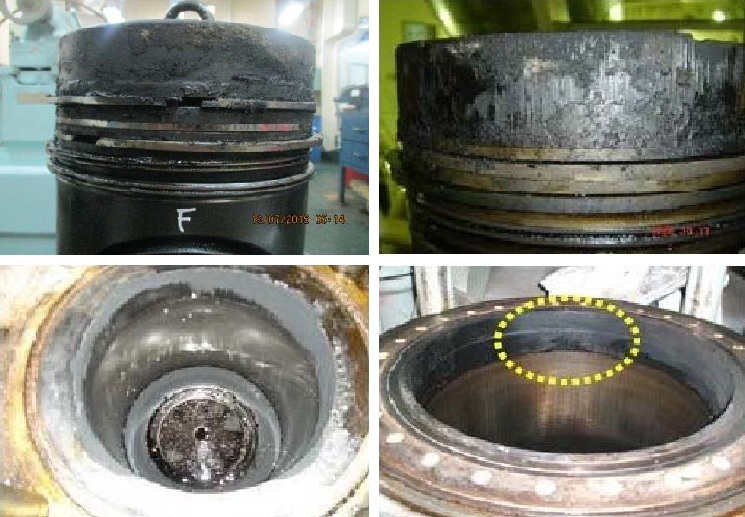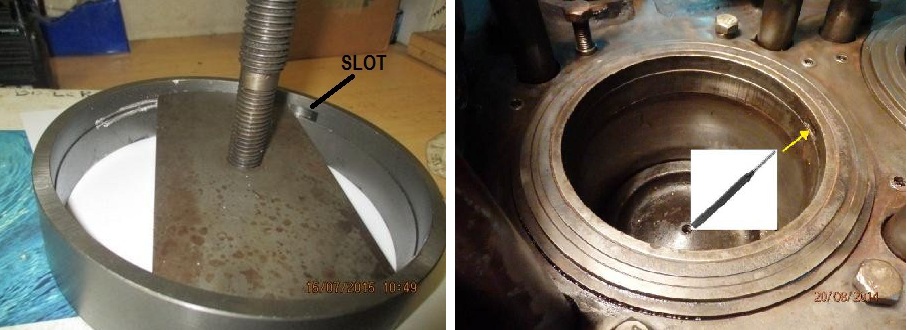What Is The Procedure For Handing Over A Watch?
The Engineer Should Not Vacate The Engine Room Until His Relief Arrives.
He Should Acquaint The Relieving Engineer Of Any Abnormal Operating Conditions That Have Occurred During The Watch.
Any Orders From The Bridge, Recorded In The Log Book Should Be Pointed Out.
Instructions From Senior Engineer Should Be Passed On.
Any Repairs Should Be Reported Together With Information On Any Machinery That Has Been Dismantled.
The Presence Of Any Other Members Of Ship's Staff In The Engine Room Should Be Reported.
The Engineer Must Ascertain That His Relief If Fit And Able Before Vacating The Machinery Space.
Explain The Bilge System From Bilge Wells To Overboard.
The Bilge Pump (Positive Displacement Pump) Takes Suction From The Bilge Well Via A Strum Box, Then Via A Strainer Before Entering The Pump Where It Is Then Discharged To The Bilge Holding Tank.
From The Bilge Tank The Oily Water Separator Takes Suction, Bilge Water Passes Through The Separator Before Being Discharged Overboard Via 15ppm Monitoring Unit, Which Will Automatically Stop The Oily Water Separator Pump And Give An Alarm If The Oily Water Mixture Exceeds 15ppm.
How Is The Signal From The Bridge When The Helm Is Moved Transmitted To The Hydraulic Rams In Steering Flat?
When The Helm On The Bridge Is Moved, Electrical Impulses Are Produced. These Impulses Are Transmitted Via An Amplifier Or Control Unit To The Steering Flat. In The Steering Flat, These Impulses Are Relayed To A Servomotor (telemotor) Which Drives An Adjusting Gear And Floating Lever Which Puts The Steering Gear Variable Delivery Pump On Stroke, Thus Creating Hydraulic Pressure In The System Which Moves The Rams, Thus Moving The Tiller And Rudder.
The Pump Is Only Required To Deliver Oil When The Helm Is Moved I.e. Once Rudder Has Matched The Helm Angle, The Control Lever Will Put The Pump Off Stroke.
Why Is A Gear Type Pump Used For Pumping Oil, While A Centrifugal Pump Is Used For Pumping Water?
A Gear Pump Is Used For Pumping Oil As It Has A High Suction Lift, Is Self Priming, Able To Produce The Discharge Pressure Required By The System And Can Handle Large Amounts Of Vapour Or Entrained Gases. It Is Also Able To Pump High Viscous Fluids.
A Centrifugal Pump Is Used For Pumping Water, As It Is Unable To Pump High Viscous Fluids Such As Oil, The Centrifugal Pump Is Not Self-Priming.
What Would Happen To The Amps Of A Centrifugal Pump If It Were Run With The Discharge Valve Shut?
The Amps Would Drop, As There Would Be No Load On The Pump.
What Steering Gear Checks Would You Do Before Sailing?
Prior To A Ship's Departure From Any Port, The Steering Gear Should Be Tested To Ensure Satisfactory Operation. These Tests Should Include:
Operation Of The Main Steering Gear
Operation Of The Auxiliary Steering Gear Or The Use Of The Second Pump Which Acts As The Auxiliary.
Operation Of The Remote Control Systems From The Main Bridge Steering Positions.
Operation Of Steering Gear Using The Emergency Power Supply.
The Rudder Angle Indicator Reading With Respect To The Actual Rudder Angle Should Be Checked.
The Alarms Fitted To The Remote Control System And Steering Gear Power Units Should Be Checked For Correct Operation.
Steering Gear Header Tank Level Should Be Checked.
During These Tests, The Rudder Should Be Moved Through Its Full Travel, In Both Port And Starboard And The Various Equipment Items, Linkages, Etc. Visually Inspected For Damage Or Wear. The Communication System Between Bridge And Steering Gear Compartment Should Also Be Operated.
What Are Normal Jacket Water Temperatures And Pressures?
Normal Jacket Water Pressures Are Between 2-3 Bar, Temperatures 80-85°C, Alarm Point At 90°C And Shut Down At 95°C .
What Is The Correct Method Of Starting And Stopping A Centrifugal Pump?
The Correct Way To Start And Stop A Centrifugal Pump Is With The Discharge Valve From The Pump Closed, I.e. Less Load On The Motor When Starting And Stopping.
What Would You Do In The Event Of An Oil Spill?
Raise The Alarm, Inform Bridge And Chief Engineer.
There Should Be A Set Drill For Oil Spills, Which Is Practised Regularly.
If Possible Contain The Spill On Deck And Start Clean Up Procedures Using Appropriate Oil Spill Equipment.
If The Oil Has Spilt Into The Sea:- If In Port, Port Authorities Should Be Informed. If At Sea, Coastguard Should Be Informed.
The Time Of Spill Should Be Recorded With The Place Or Position Of Ship At The Time Of Spill Along With Approximate Quantity And Type Of Oil.
Circumstances Of Discharge Or Escape Would Be Logged In Oil Record Book And Engine Room Log Book.
Why Are High And Low Suctions Fitted On Fuel Oil Service Tanks?
The High And Low Suctions Are A Safety Feature To Prevent Invertent Shut Down Of Main Engines, Generators And Boilers Due To Water Contamination Of The Fuel. Normally The Low Suction Is Kept In Use. If Any Water Should Find Its Way Into The Fuel And Service Tank, It Will Gradually Separate Towards The Tank Bottom. When It Becomes Apparent Water Is Present By Finding It At The Tank Drains Or By Operation Of The Engine, It Is Possible To Bring The High Suction Into Operation And Avoid Shut Down.
Describe The Duties Of A Duty Engineer.
Regularly Check And Record All Pressures And Temperatures In The Engine Room Log.
Pay Attention To Readings For Deviation From Normal, Particular Attention Being Made To Exhaust Gas Temperature, Scavenge Temperatures And Pressures And Turbo Charger Revs.
Adjustments Should Be Made For Sea Water Temperature Changes To Keep Correct Temperatures And Pressures.
Checks Should Be Made On The Pressure Drops Across Fuel And Lubrication Filters To See That They Are Operating Within Required Limits.
Check All Oil Levels In Auxiliary Machinery: Main Engine Sump Levels, Cylinder Lubricators, Turbo Charges, Governors.
Check Around All Bearings And Crankcase Doors Using Palm Of The Hand To Feel For Any Increase In Temperature.
Ensure That Fuel In The Daily Service Tanks Is At Correct Levels And That It Is Sludged And Drained Of Water.
Depending On Type Of Purifiers Fitted, Sludge And Drain, Check Oil Level, Signs Of Vibration And Clean If Required.
Carry Out All Routine Assignments As Recommended By Engine Builders Or The Company.
At All Times Use Sight, Smell And Hearing, As This Is Often The First Sign Of A Fault Developing In The Engine Room.
Check Bilge Levels, Stern Gland, Air Start Bottles And Maintain Correct Levels And Pressures.
Record And Fuel/Lub Oil Transfers And Any Irregularities In Log.
What Are The Uses Of Centrifugal Pumps, Positive Displacement Pumps And Gear Pumps On Board A Ship?
Centrifugal Pumps: Seawater Cooling Pumps, Jacket Water Cooling Pumps, Boiler Feed Pumps (Multi Stage Pumps)
Positive Displacement Pumps: Bilge Pumps, Steering Gear Pumps, Cargo Shipping Pumps.
Gear Type Pumps: Fuel Oil Booster Pumps, Fuel Oil Transfer Pumps, Engine Lub Oil Pumps.
Why Are Weighted Cocks Fitted To Sounding Pipes Of Fuel Oil Tanks?
Weighted Cocks Are Fitted To Sounding Pipes Of Fuel Oil Tanks To Prevent Fuel Oil Spills From Overflows. They Also Prevent Vapours Escaping From Tanks.
Describe Different Types Of Cooling Systems I.e. Seawater Cooling System And Central Cooling System.
A Seawater Cooling System Is An Arrangement That Uses Individual Coolers For Lub Oil, Jacket Water And The Piston Cooling System. Each Cooler Being Circulated By Sea Water.
As Where Some Modern Ships Use A Central Cooling System With Only One Large Sea Water Circulated Cooler. This Cools A Supply Of Fresh Water, Which Then Circulates To The Other Individual Coolers. With Less Equipment In Contact With Sea Water, The Corrosion Problems Are Much Reduced In This System.
How Many Pumps Are There In The Engine Room That You Can Pump Bilges With?
A Bilge Pump Which Is Normally Positive Displacement.
The Others May Vary From Ship To Ship, But Can Be The Ballast Pump, General Service Pump And Main Sea Water Cooling Pump. These Pumps Are Only Used For Pumping Bilges In The Event Of An Emergency And Have An Emergency Bilge Suction/Injection Valve Connected To Them.
Give Possible Reasons Why The Engine Room Bilge Pump May Not Be Able To Empty Bilges.
The Strum Box From The Bilge May Be Fowled.
Bilge Pump Suction Strainer May Be Blocked.
A Valve May Be Left Open From An Empty Bilge.
There Could Be A Hole In The System On The Suction Side Of The Pump.
Depending On Type Of Bilge Pump, The Pump Suction Or Discharge Valves May Need Overhauling.
Why Would The Bridge Need To Be Informed That The Engine Is About To Be Stopped?
The Bridge Would Need To Be Informed That The Engine Was About To Be Stopped To Ensure It Was Navigationally Safe To Do So, I.e. Not In Busy Shipping Lanes Or Near Land.


































 Power Piston
Power Piston